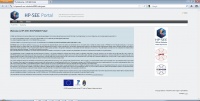DiseaseGene
From HP-SEE Wiki
General Information
- Application's name: In-silico Disease Gene Mapper
- Application's acronym: DiseaseGene
- Virtual Research Community: Life Sciences
- Scientific contact: Kozlovszky Miklos, Windisch Gergely; m.kozlovszky at sztaki.hu
- Technical contact: Kozlovszky Miklos, Windisch Gergely; m.kozlovszky at sztaki.hu
- Developers: Windisch Gergely, Biotech Group, Obuda University – John von Neumann Faculty of Informatics
- Web site: http://ls-hpsee.nik.uni-obuda.hu:8080
Short Description
Complex data mining and data processing tool using large-scale external open-access databases. The aim of the task is to port a data mining tool to the SEE-HPC infrastructure, which can help researchers to do comparative analysis and target candidate genes for further research of polygene type diseases. The implemented solution is capable to target candidate genes for various diseases such as asthma, diabetes, epilepsy, hypertension or schizophrenia using external online open-access eukaryotic (animal: mouse, rat, B. rerio, etc.) databases. The application does an in-silico mapping between the genes coming from the different model animals and search for unexplored potential target genes. With small modification the application is useful to target human genes too.
Problems Solved
The implemented solution is capable to target candidate genes for various diseases such as asthma, diabetes, epilepsy, hypertension or schizophrenia using external online open-access eukaryotic (animal: mouse, rat, B. rerio, etc.) databases. The application does an in-silico mapping between the genes coming from the different model animals and search for unexplored potential target genes. With small modification the application is useful to target human genes too. Grid's reliability parameters and response time (1-5 min) is not suitable for such service.
Scientific and Social Impact
Researchers in the region will be able to target candidate genes for further research of polygene type diseases. Create a data mining a service to the SEE-HPC infrastructure, which can help researchers to do comparative analysis.
Collaborations
Ongoing collaborations so far: Hungarian Bioinformatics Association, Semmelweis University
Beneficiaries
People who are interested in using short fragment alignments will greatly benefit from the availability of this service. The service will be freely available to the LS community. We estimate that a number of 2-5 scientific groups (5-15 researchers) world wide will use our service.
Number of users
6
Development Plan
- Concept: .
- Start of alpha stage: .
- Start of beta stage: .
- Start of testing stage: .
- Start of deployment stage: .
- Start of production stage: .
Resource Requirements
- Number of cores required for a single run: 128 – 256
- Minimum RAM/core required: 4 - 8 GB
- Storage space during a single run: 2-5 GB
- Long-term data storage: 5-10TB
- Total core hours required: .
Technical Features and HP-SEE Implementation
- Primary programming language: C/C++
- Parallel programming paradigm: Clustered multiprocessing (ex. using MPI) + Multiple serial jobs (data-splitting, parametric studies)
- Main parallel code: WS-PGRADE/gUSE and C/C++
- Pre/post processing code: Perl/BioPerl (in-house development)
- Application tools and libraries: Perl/BioPerl (in-house development)
Usage Example
1. HP-SEE’S BIOINFORMATICS ESCIENCE GATEWAY
The Bioinformatics eScience Gateway based on gUSE and operates within the Life Science VO of the HP-SEE infrastructure. It provides unified GUI of different bioinformatics applications (such as a gene mapper applications and sequence alignment applications) and enables end-user access indirectly to some open European bioinformatics databases. gUSE is basically a virtualization environment providing large set of high-level DCI services by which interoperation among classical service and desktop grids, clouds and clusters, unique web services and user communities can be achieved in a scalable way. gUSE has a graphical user interface, which is called WS-PGRADE. All part of gUSE is implemented as a set of Web services. WS-PGRADE uses the client APIs of gUSE services to turn user requests into sequences of gUSE specific Web service calls. Our bioinformaticians need application specific portlets to make the usage of the portal more customized for their work. In order to support the development of such application specific UI we have used the Application Specific Module (ASM) API of the gUSE by which such customization can easily and quickly be done. Some other remaining features were included from WS-PGRADE. Our GUI is built up from JSR168 compliant portlets and can be accessed via normal Web browsers (shown in Fig. 1.).
Infrastructure Usage
- Home system: .
- Applied for access on: .
- Access granted on: .
- Achieved scalability: .
- Accessed production systems:
- .
- Applied for access on: .
- Access granted on: .
- Achieved scalability: .
- Porting activities: .
- Scalability studies: .
Running on Several HP-SEE Centres
- Benchmarking activities and results: .
- Other issues: .
Achieved Results
Publications
- M. Kozlovszky, G. Windisch; Supported bioinformatics applications of the HP-SEE project’s infrastructure; Networkshop 2012, accepted
